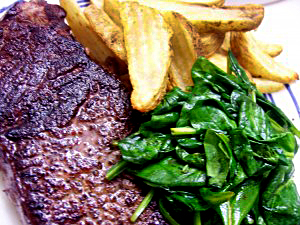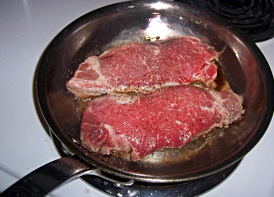
Welcome back to school, everybody. It’s cold and wet outside, and you’re probably hankering for a warm, stick-to-your-guts, filling dinner. Well, look no further. For last night’s dinner, I had a couple of New York Strip steaks.
Many people are intimidated by cooking a steak. Steaks tend to be a little pricey and, if you don’t know what you’re doing, hard to cook properly. But really, there’s just one secret to cooking a good steak. Are you ready?
Don’t overcook it.
Overcooking is steak death. Too much time on the heat makes a steak dry and tough, which is not tasty.
You need
- One pan. Preferably not non-stick (so, stick?) but it really doesn’t matter much.
- One steak. Cuts that are good for cooking at high heat for a short amount of time or grilling: New York Strip, Porterhouse, T-bone, sirloin, top round, or even tenderloin (which is considered the granddaddy of all steaks but because it is very lean can have less flavor). Avoid brisket, chuck, bottom round, shoulder and flank steak, as these are best for cooking long and at low heat. You want to pick one that’s fairly thick, and not brown but also not too red. You may be concerned that red meat is unhealthy. It can be, but if you keep it proportional and lean (meaning minimal fat), then it’s a good source of protein (which, for all you dieters out there who shun red meat, keeps you fuller longer. So you won’t eat more later). The proper proportion for an average female is roughly the size of a deck of cards. The average male can eat a bit more (the bastards) but 32oz slabs aren’t the way to go.
- Salt
- Pepper
- Olive Oil
- Butter
- Optional but really recommended: Red Wine (3 buck chuck!), beef stock/broth or even water. This is for deglazing the pan after you cook the steak to make a sauce. Deglazing is when you use a liquid on a hot pan to pick up the brown bits stuck to the bottom (which are tasty).
Directions
- Heat up the pan. You want it pretty hot, medium to medium-high depending on how hot your stove gets. I am using a fair but excitable Stuvi oven, so 6 or 7 (out of 10) is good for me.
- Season the steak. To do this, rub one or two teaspoons of olive oil on the steak. We’re putting it on the steak because it will just sputter around in the hot pan and splatter on your Old Navy Performance Fleece if you heat up the oil in the pan. Now, sprinkle about 2 big pinches of salt and 3 big pinches of pepper on the oiled steak. Its going to look like a lot, but it’s meant to season the whole steak. Don’t be afraid. You might want to take off your Old Navy Performance Fleece at this point. It’s about to get rather warm.
- Put the steak in the hot pan, seasoned side down. Important: DON’T MOVE IT. Let the heat do its thing. You want to get a nice browned crust on the surface, and this is achieved by just letting it be.
- Season the other side of the steak. Just like the first side.
- Let it cook for 3-4 minutes depending on the thickness of the steak.
- Flip it over. Optional but really recommended: I put a tablespoon of butter to melt on the browned side of the steak while the other side is cooking. I think it helps with the juiciness and flavor of the steak.
- Cook for another three minutes. Again, this is depending on the thickness of your steak and your done-ness preference. Remember that you can always cook it more if it’s underdone, but you can’t uncook it once it’s overdone.
- Transfer to a plate. Let it rest for a few minutes while you make the sauce to go on top. It’s important to let it rest so it can finish cooking and redistribute the juices before you cut it. Cutting too early makes all the juices run out= dry tough steak=steak death.
- Lower the heat on the pan to medium or medium low (about a 4 on my Stuvi oven). Pour in ½ cup of red wine, broth or water. Let it simmer for a bit, then use a spatula or a whisk to scrape up the brown bits at the bottom of the pan (incidentally, those brown bits are called fond. Impress people with your culinary knowledge by throwing that into casual conversation). Add salt and pepper (small pinches). Let this reduce for another couple of minutes. Turn off the heat and add one more tablespoon of butter (or cream if you want!).
- Spoon some sauce on top of the steak. Serve with some salad, or mashed potatoes, or steamed green beans. Tonight we had some baked potato wedges and spinach that I sauteed in the pan drippings for a few minutes.
- Drink the rest of the wine.
Recap

- Steak
- Pan
- Salt, Pepper, Olive Oil, Butter
- Red Wine, Beef broth/stock, water
Accompaniments: Vegetable (please).
Dishes dirtied: one pan, one plate.
Time: What, like 15, 20 minutes tops? You have time for that.
Verdict: Tasty. Steak can be a great source of lean protein, which is important for gaining muscle, which in turn leads to weight loss. Lean beef is high in protein as well as Vitamin B12 and B6.

i love this! i’ve been intimidated to venture out of the worlds of soup and sandwiches in my dorm kitchen, but you’ve definitely made steaks more accessible. yay! 🙂
Great article!
How much would it cost to have you make that for me at my place? ^^